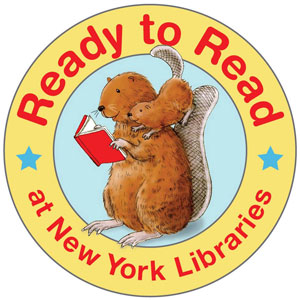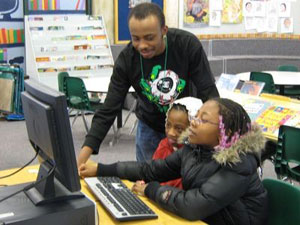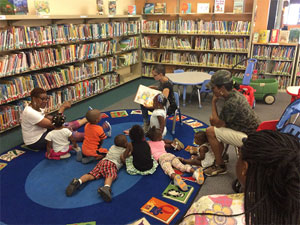Blog Posts | June 28, 2018
Share This
Editor’s Note: This post is derived from remarks that IMLS Director Dr. Kathryn Matthew made on April 9, 2018, at the New York State Library Bicentennial.
It’s not just any old birthday. On the occasion of New York State Library’s bicentennial, IMLS took a look at the humble beginnings of both NYSL and public libraries, and how the state is looking to the future.
The Public Library: A Brief History
Public libraries in America have a long history, having taken various forms on their path to becoming the institutions many of us recognize today. Their foundations go back to private membership libraries, such as Benjamin Franklin’s Library Company, which began in the 1730s.
Soon after, a competitor to this member-restricted model emerged. Social libraries’ circulating collections usually involved a fee or subscription, but were open to a wider audience.

Along the way, various groups created their own models that fostered literacy and cultivated character. In the North, free blacks organized literary societies that sponsored reading rooms and debates that challenged the slavery and racism. There were also ladies’ literary societies in New York and Philadelphia, lyceums to promote public speaking and lectures on science, and athenaeums in Boston and Philadelphia.
Many of these models did not survive beyond the mid-19th century. Others adapted, as with membership libraries, which took on some of the characteristics of social libraries, like less-restrictive barriers to entry.
Following the 1818 creation of the New York State Library, New York Secretary of State John Adams Dix proposed a library model in 1834 that would pave the way for the first public library system.
“If the inhabitants of school districts were authorized to lay a tax upon their property for the purpose of purchasing libraries for the use of the district, such a power might…become a most efficient instrument in diffusing useful knowledge, and in elevating the intellectual character of the people.”
–John Adams Dix, New York Secretary of State (1834)
In 1835, the New York State Legislature passed legislation to establish school district libraries that local citizens could access. Four years later, districts were permitted to establish libraries, and the legislature set aside $55,000 annually to be given on a matching-fund basis for the establishment of school libraries. Fifteen years later, these public libraries housed 1.5 million books.
The New York State Library Today

Its long history notwithstanding, the New York State Library (NYSL) is still very relevant today. As a State Library Administrative Agency, NYSL is part of IMLS’s largest program, Grants to States, and it serves as an illustrative example of how libraries have adapted to current needs. With more than $8.2 million in funding from the Grants to States program this fiscal year, NYSL has been prioritizing access to information, literacy, and building strong library leadership for the future.
Some of these initiatives are targeted to the youngest of learners. In 2014, IMLS awarded NYSL a planning grant through the Laura Bush 21st Century Librarian Program to improve the quality of early literacy services and programs delivered statewide. For this project, NYSL focused on library staff’s skills in community assessment, outreach, and parent/caregiver education.

Building on this grant, NYSL implemented the Ready to Read at New York Libraries program with IMLS Grants to States funding. The goal was to provide families and caregivers in communities across the state with the knowledge needed to prepare young children for school years ahead. NYSL used a train-the-trainer approach to strengthen library staff skills in this area, and throughout, the project has featured strong partnerships at the state and local levels.
NYSL also focuses on increasing access, and these efforts have had tremendous reach. NYSL has used Grants to States funds to support ongoing projects such as the New York Online Virtual Electronic Library, NOVEL.ny, which provides residents free, reliable information through database licensing. Between 2014 and 2016, the service hosted 76 million searches and has become indispensable to student success.
Summer reading is another mainstay of IMLS library funding in New York. Organized each year by NYSL, the summer reading campaign typically involves a breadth of partners, from 4-H and Hunger Solutions NY to the National Library of Medicine and the New York State Senate and Assembly.

Other library priorities center on high-need populations and equity of access. NYSL uses IMLS funds to deliver library services for various adult populations, including re-entry resources for inmates through the state’s 23 public library systems and Department of Corrections. Additional programs under this banner include adult literacy services and workforce development programs.
Connectivity is also an essential area for the state library, and IMLS grant funds ensure that libraries seeking affordable broadband have the technical assistance they need. In 2015 alone, this program helped 308 libraries obtain over $10 million in discounts through the E-Rate program.
IMLS will continue to explore the ways libraries such as NYSL can increase public access, support lifelong learning, and build capacity in communities for the future. We value opportunities to hear from the museum and library fields and explore new ideas together.
